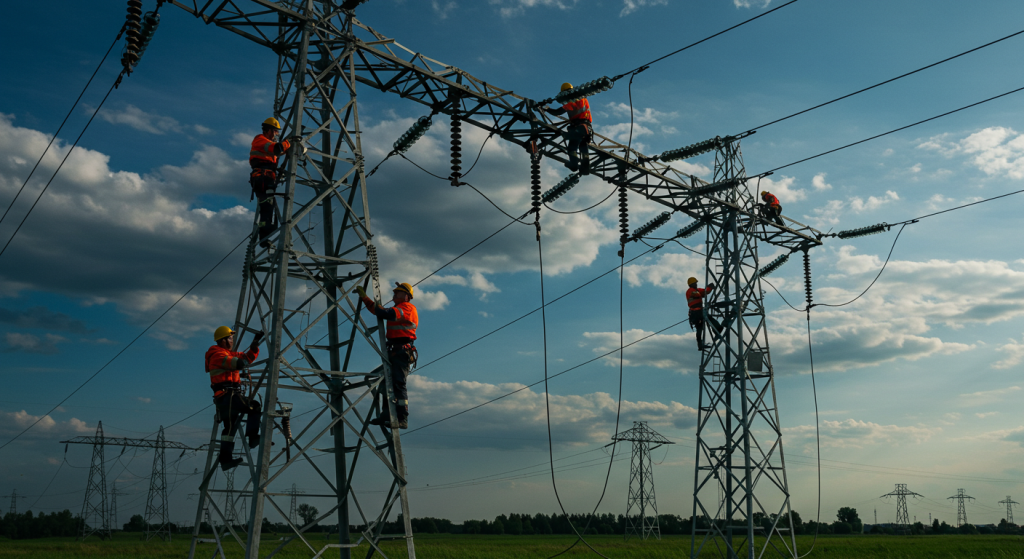High-Voltage Transmission Line Maintenance Tips for 2025
2025-03-20
High-Voltage Transmission Line Maintenance: Ensuring Power Grid Reliability
The high-voltage transmission line maintenance is essential for effective power because it minimizes outages and increases power grid reliability. High-voltage transmission lines are the last leg in the transmission process to and from generation stations back to the end-use customer. Thus, any adjustments, corrections, and replacements made over time as part of a continual effort safeguard against failures and keep proper transmission on the right track.
Why is High Voltage Transmission Line Maintenance Necessary?
High voltage transmission lines are a critical component of the electricity delivery system. They transmit high voltage electricity for long distances over short distances, and without required efforts, the need for repairs occurs. Repairs occur with efforts elsewhere that tackle the power delivery system at risk. Therefore, maintenance reduces the need for:
- Stability and lifespan of the power network.
- Cost-effective operation for the power companies.
- Protection of valuable assets such as insulators, conductors, and towers.
Key Aspects of High-Voltage Transmission Line Maintenance
Transmission Line Maintenance is a catch-all for everything from an ocular assessment to a foundational replacement.
Transmission Line Maintenance Assessment:
To keep equipment from failing down the road, transmission line assessments are needed. Whether at eye level or above, drones facilitate assessments from a distance. Yet, sometimes, the type of assessment needed is line-to-line, and for that type, helicopters enable the company to gauge the condition of the lines without putting personnel at risk or in inaccessible locations. Relative assessments include line assessment thermographic (infrared) assessments.
- Line assessments drone & helicopter.
- Corona scans for hot-spotting electrical discharges.
This means that overhead (or extensive) upgrades and replacements are upgrades and replacements that suggest future breakage based on current use. Where usage does not necessarily identify problems needing upgrades and replacements, internal use does, like annual inspections, trimming, etc. Above upgrades and replacements come from failures experienced, but technology enables suggesting when such replacements or upgrades are better to keep utility systems in functioning order.
Technologies Used to Evaluate Overhead Upgrades and Replacements:
- Overhead clearance inspections.
- Overhead stability tests.
- Above-ground rust inspections.
Such programs typically reduce the probability of premature repairs and replacements, and outages, that promote a longer life for overhead at the same time.
Overhead Replacement and Repair
If faults are found or if the line is physically compromised, line repairs occur, including the replacement of any number of wires, insulators, or hardware. Sag repairs also occur which prevent a wire/sag from going too low for clearances, a public safety issue, or further damage. The following are repairs that occur:
- Repairs to insulators
- Repairs to conductors
- Repairs to various tower parts
Vegetation Management and Right-of-Way Maintenance
The second maintenance concern relates to vegetation management for high-voltage transmission. This is involved with right-of-way maintenance and vegetation management so that trees and shrubs do not grow too close to these lines. In other words, this vegetation management ensures proper tree trimming and growth limitations in certain public spaces to prevent unintentional arbors from growing into high-voltage wires—and causing shorts—that might produce massive wildfires.

The Role of Technology in Transmission Line Maintenance
Aerial and Drone Inspection is essential because technology improves the safety and evaluation of high-voltage transmission lines. Technological Innovations include
- Drones and Helicopter Inspections.
Utility inspections are performed in the field through drones and helicopters in otherwise hard-to-reach places, requiring less human effort and less time spent inspecting the utility. These devices offer near real-time reporting, HD images, and videos so utilities know when there’s too much corrosion, drooping lines, rotting insulation, etc.
- Smart Sensors and Monitoring Systems:
Smart sensors placed on transmission lines in otherwise hard-to-reach places give linemen real-time feedback about the condition of the line so they can determine what they need to do with certainty. They know when a line has corona discharges, is overheating, or has too much tension/too little tension. Advantages of smart monitoring:
• Predictive maintenance.
• Enhanced energy management.
• Greater operational effectiveness.
- Thermographic and Fault Detection Technologies
Safety and Reliability Technology encompasses safety/thermographic surveys using infrared cameras that depict heat anomalies on the rails, which indicate problem areas; furthermore, fault detection technology reveals precisely where the issue is so it can be fixed before more extensive damage occurs.
Safety Regulations and Standards
Maintenance happens under high voltage safety. These are the areas where high-voltage power lines are maintained, and the need for safety is paramount. High voltage safety considerations are the requirements to ensure the employee is safe. Therefore, OSHA’s transmission line work safety considerations and the NESC standards ensure that this type of work is done in a professionally expected and safe environment.
These include:
• Electric safety training
• PPE
• Hotline maintenance considerations
• The requirement for work sites to be in restricted, off-limit sites.
Challenges in Remote and Difficult Terrain
Transmission lines are located in some pretty out-of-the-way places. They cross mountains, pass through forests, and coast the shoreline. In addition, inspections of transmission lines that are just as remote are complicated by testers having to reach such out-of-the-way places. According to Energy Central, a helicopter transmission line inspection—or a drone inspection that gives utilities a bird’s-eye view—helps to avoid disaster.
Cost Considerations in High-Voltage Transmission Line Maintenance
- High-voltage transmission line maintenance costs are not too astronomical, aside from the specially trained staff or equipment required for specific operational needs; then, it’s sky-high. But not as sky-high as the avoided costs of catastrophic failures, blackouts, and reduced life expectancies.
- Ultimately, the maintenance costs for high-voltage transmission lines are a necessary expense to ensure a functioning and effective electric grid. Assessment of the lines with proper diagnostic resources and preventative safety measures ensures the electric provider avoids additional power outages and increases electric grid safety in the future.
Conclusion
With an increase in reliance on energy systems and increasingly complex energy distribution systems, the demand for high-voltage transmission line maintenance in the future will grow exponentially. The future of power line maintenance will be sensor and technology-driven—from assessment to action. Visit XY Tower to learn more about our services for transmission line repairs.

Привет, я Чуньцзянь Шу
"X.Y. Tower: Надежные, инновационные решения для высококачественных башен и электрооборудования с профессиональным сервисным обслуживанием.
